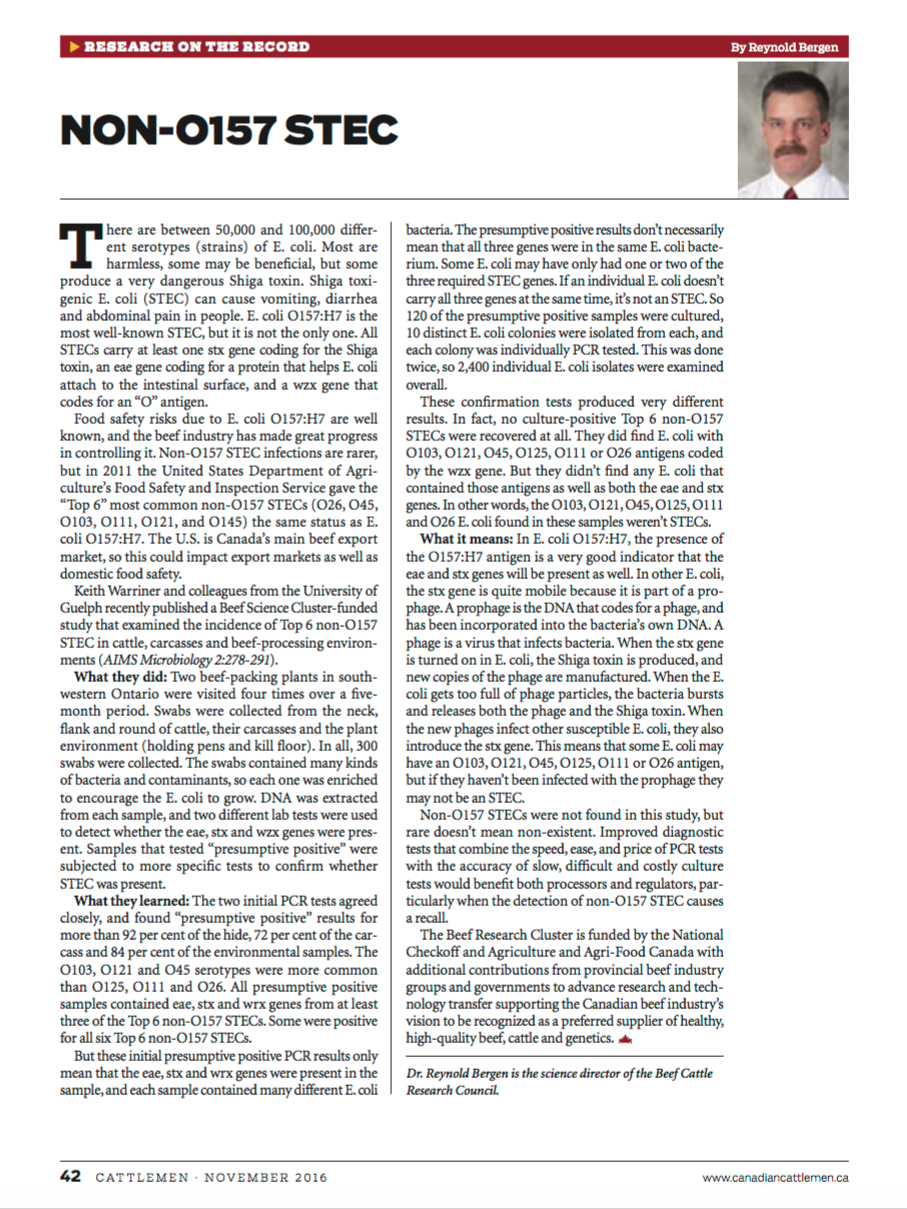Non-O157 STEC
This article written by Dr. Reynold Bergen, BCRC Science Director, originally appeared in the November 2016 issue of Canadian Cattlemen magazine and is reprinted on the BCRC Blog with permission of the publisher.
There are between 50,000 and 100,000 different serotypes (strains) of E. coli. Most are harmless, some may be beneficial, but some produce a very dangerous Shiga toxin. Shiga toxigenic E. coli (STEC) can cause vomiting, diarrhea and abdominal pain in people. E. coli O157:H7 is the most well-known STEC, but it is not the only one.
All STEC’s carry at least one stx gene coding for the Shiga toxin, an eae gene coding for a protein that helps E. coli attach to the intestinal surface, and a wzx gene that codes for an “O” antigen. All three of those genes must be present in the E. coli cell for it to be a STEC.
Food safety risks due to E. coli O157:H7 are well known, and the beef industry has made great progress in controlling it. Non-O157 STEC infections are rarer, but in 2011 the United States Department of Agriculture’s Food Safety and Inspection Service gave the “Top 6” most common non-O157 STECs (O26, O45, O103, O111, O121, and O145) the same status as E. coli O157:H7. The US is Canada’s main beef export market, so our beef processing industry needs to understand how we may be impacted.
Keith Warriner and colleagues from the University of Guelph recently published a Beef Science Cluster funded study that examined the incidence of Top 6 non-O157 STEC in cattle, carcasses and beef processing environments (AIMS Microbiology 2:278-291).
What they did
Two beef packing plants in southwestern Ontario were visited four times over a five-month period. Swabs were collected from the neck, flank and round of cattle, their carcasses and the plant environment (holding pens and kill floor). In all, 300 swabs were collected. The swabs contained many kinds of bacteria and contaminants, so each one was enriched to encourage the E. coli to grow. DNA was extracted from each sample, and two different PCR tests were used to detect whether the eae, stx and wzx genes were present. Samples that tested “presumptive positive” were subjected to more specific tests to confirm whether STEC were present.
What they learned
The two initial PCR tests agreed closely, and found “presumptive positive” results for more than 92% of the hide, 72% of the carcass and 84% of the environmental samples. The O103, O121 and O45 serotypes were more common than O125, O111 and O26. All presumptive positive samples contained eae, stx and wrx genes from at least three of the Top 6 non-O157 STECs. Some were positive for all six Top 6 non-O157 STECs
But these initial presumptive positive PCR results only mean that the eae, stx and wrx genes were present in the sample, and each sample contained many different E. coli bacteria. The presumptive positive results don’t necessarily mean that all three genes were in the same E. coli bacterium. Some E. coli may have only had one or two of the three required STEC genes. If an individual E. coli doesn’t carry all three genes at the same time, it’s not an STEC. So 120 of the presumptive positive samples were cultured, 10 distinct E. coli colonies were isolated from each, and each colony was individually PCR tested. This was done twice, so 2400 individual E. coli isolates were examined overall.
These confirmation tests produced very different results than the presumptive tests. In fact, no culture-positive Top 6 non-O157 STEC were recovered at all. They did find E. coli with O103, O121, O45, O125, O111 or O26 antigens coded by the wzx gene. But they didn’t find any E. coli that contained those antigens as well as both the eae and stx genes. In other words, the O103, O121, O45, O125, O111 and O26 E. coli found in these samples weren’t STEC’s.
What it means
In E. coli O157:H7, the presence of the O157:H7 antigen is a very good indicator that the eae and stx genes will be present as well. In other E. coli, the stx gene is quite mobile because it is part of a prophage. A prophage is the DNA that codes for a phage, and has been incorporated into the bacteria’s own DNA. A phage is a virus that infects bacteria. When the stx gene is turned on in E. coli, the shiga toxin gets produced, and new copies of the phage get manufactured. When the E. coli gets too full of phage particles, the bacteria bursts and releases both the phage and the shiga toxin. When the new phages infect other susceptible E. coli, they also introduce the stx gene. This means that some E. coli may have an O103, O121, O45, O125, O111 or O26 antigen, but if they haven’t been infected with the prophage they may not be a STEC.
Non-O157 STEC’s were not found in this study, but rare doesn’t mean non-existent. Improved diagnostic tests that combine the speed, ease, and price of PCR tests with the accuracy of slow, difficult and costly culture tests would benefit both processors and regulators, particularly when the detection of non-O157 STEC causes a recall.
Click here to subscribe to the BCRC Blog and receive email notifications when new content is posted.
The sharing or reprinting of BCRC Blog articles is typically welcome and encouraged, however this article requires permission of the original publisher.
We welcome your questions, comments and suggestions. Contact us directly or generate public discussion by posting your thoughts below.
